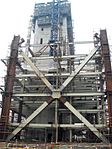Structural engineering facts for kids
Structural engineering is a special part of civil engineering. It's all about designing and making sure that buildings and other big structures are strong enough. These structures need to stand up against things like gravity (which pulls everything down), wind, and even natural events like earthquakes.
Structural engineers also help design things like machines, medical equipment, and vehicles. They make sure these items are safe and work properly. Every design they create must follow important building codes to ensure safety.
Big structural engineering projects usually go through four main steps:
- Research: This is where engineers study and gather information.
- Design: They create plans and drawings for the structure.
- Testing: They check if the design will work and is safe.
- Construction: Finally, they build the structure.
You can see some of these steps in the images below:
Structural engineering has been around since humans first started building. It became a more official job during the Industrial Revolution in the late 1800s. This was when many new types of buildings and machines were being made.
Contents
What Structural Engineers Do
When engineers are just starting out, they might design smaller parts of a structure. For example, they could design the beams, columns, or floors of a building. More experienced engineers are in charge of the whole structure. They make sure the entire building or bridge is strong and safe.
Structural engineers often choose to focus on specific areas. Some might work on bridges, while others specialize in buildings. There are also engineers who design pipelines, industrial factories, or special moving structures like vehicles or aircrafts.
History of Structural Engineering
People have been building strong structures for thousands of years. Ancient civilizations built amazing things like pyramids and aqueducts. These early builders used their knowledge to make sure their creations lasted.
Over time, smart thinkers helped develop the science behind structural engineering.
- Galileo Galilei (in the 1600s) studied how structures could break.
- Isaac Newton (also in the 1600s) developed laws about motion and forces. These laws are very important for understanding how structures behave.
- Leonhard Euler (in the 1700s) figured out how columns might bend or "buckle" under weight.
These discoveries helped engineers design even safer and stronger structures.
Famous Structures and Engineers
Many famous buildings and bridges around the world are great examples of structural engineering.
- The Eiffel Tower in Paris is a famous landmark. It shows how strong metal structures can be.
- The Sydney Opera House has a unique shell-like roof. Its design required very clever engineering.
- The Burj Khalifa in Dubai is the tallest building in the world. Building something so high needs incredible structural planning.
- The Gateway Arch in St. Louis, USA, is another amazing example. It's a tall, curved arch made of steel.
These structures show how engineers combine science, math, and creativity. They make our world safer and more interesting.
Related pages
Images for kids
-
The Eiffel Tower in Paris is a historical achievement of structural engineering.
-
Galileo Galilei examined how simple structures fail.
-
Isaac Newton published Philosophiae Naturalis Principia Mathematica which contains the Newton's laws of motion.
-
Leonhard Euler developed the theory of buckling of columns.
-
Earthquake-proof pyramid El Castillo, Chichen Itza.
-
Car.
-
Pont du Gard, France, a Roman era aqueduct circa 19 BC.
-
Sydney Opera House, designed by Architect Jørn Utzon and structural design by Ove Arup & Partners.
-
Millennium Dome in London, UK, by Richard Rogers and Buro Happold.
-
Burj Khalifa, in Dubai, the world's tallest building, shown under construction in 2007 (since completed).
-
An Airbus A380, the world's largest passenger airliner.
-
Little Belt: a truss bridge in Denmark.
-
The McDonnell Planetarium by Gyo Obata in St Louis, Missouri, USA, a concrete shell structure.
-
The 630 foot (192 m) high, stainless-clad (type 304) Gateway Arch in Saint Louis, Missouri.
-
Classical columns composed of stacked stone segments and finished in the Corinthian style (Temple of Bel, Syria).
See also
 In Spanish: Ingeniería estructural para niños
In Spanish: Ingeniería estructural para niños






















